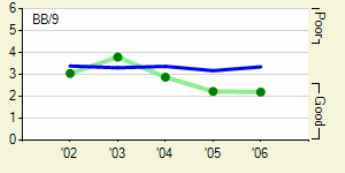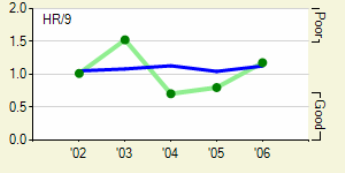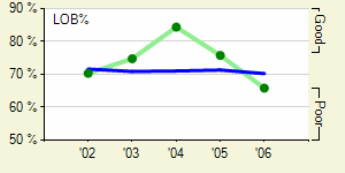
| Baseball Beat | July 08, 2006 |
On the surface, it appears as if Jake Peavy is having a poor season. His record stands at 4-8 with a 4.46 ERA. So what's wrong with Peavy, you ask? Well, not much.
Let's compare his vital stats this year to those in 2004 when he led the National League in ERA:
G GS W-L IP H R ER HR BB SO ERA BR/9 H/9 BB/9 K/9 K/BB
2004 27 27 15-6 166.1 146 49 42 13 53 173 2.27 11.34 7.90 2.87 9.36 3.26
2006 17 17 4-8 107.0 102 53 53 14 26 118 4.46 10.98 8.58 2.19 9.93 4.54
Peavy is actually walking fewer batters (top left graph below) and striking out more (top right) per nine innings in 2006 than 2004, yet his ERA is more than TWO runs higher this year. That's almost impossible. How can that be? The obvious answer is that Jake is serving up more gopher balls (bottom left) this season (1.18 per 9 IP) than two years ago (0.70/9).
A closer examination shows that Peavy is giving up more flyballs (45.7% vs. 37.0%) and a greater percentage of those batted balls are leaving the ballpark (10.4% vs. 8.0%). But there are some other factors at play here. Consider that the 25-year-old right-hander has yet to allow an unearned run this year, whereas he gave up seven such runs in 2004. Furthermore, Jake's batting average on balls in play (BABIP) is a tad higher (.324) than it was two years ago (.310) despite the increase in flyballs and a decrease in groundballs.
Perhaps due to the reduction in grounders, Peavy is inducing fewer GIDP (0.34 per 9 IP vs. 0.92/9 in 2004). Jake is also allowing more stolen bases (1.26 SB/9 IP) than before (0.87).
Thanks to sites such as The Hardball Times and Fan Graphs, we can also ascertain one other important variable that gets little, if any, attention even among the stathead crowd. Peavy's LOB% was 84.0% in 2004 and is just 70.0% in 2006 (bottom right). That is an important difference. The 6-foot-1, 180-pounder was lights out with runners on base two years ago (.218/.311/.324) compared to the current campaign (.250/.315/.424).
With respect to the difference in Peavy's won-loss records, look no further than run support. When Peavy was 15-6 in 2004, the Padres averaged 6.44 runs per nine innings while he was the pitcher of record. His run support ranked 12th out of 86 qualified pitchers. This year, his teammates are scoring 4.21 runs per 9 IP, ranking him 82nd among 93 qualified pitchers.
The bottom line is that Peavy's Expected Fielding Independent Pitching (xFIP) is virtually the same this year (3.50) as it was in 2004 (3.56). In other words, the native of Mobile, Alabama hasn't lost much, if anything. He is basically the same pitcher. You just wouldn't know it by looking at his win-loss records and ERAs.




Graphs courtesy of Fan Graphs.
Comments
Nice analysis, Rich. From watching him, the biggest difference this year from the last two seems to be in batters' ability to foul pitches off. Last year, Peavy averaged 3.89 P/PA, and for his career prior to this season, he'd always been between 3.78 and 3.90. This year, however, he's at 4.02. That's not a huge difference, but it does mean that he's working harder to achieve the same results. As a fan it is frustrating to watch him try to throw everything past hitters even when that approach isn't working. He has a better defense behind him now than he ever has before -- it would be good to see him use it.
Posted by: Geoff Young at July 8, 2006 10:58 AM
I'm not a big fan of these statistics. Just watching Peavy it's clear he isn't as good as he was last year. For all these indicators if one is inclined you can find one that show he hasn't been as dominant.
BABIP is one of the most abused statistics out there, and I've seen more ridiculous arguments made with it than any other statistic. People have shown with BABIP that Jeff Weaver hasn't really been bad this year, it's all just been some kind of illusion. My favorite is one blogger who demonstrated with charts and graphs and statistics like BABIP that Jeremy Affeldt was actually a good but unlikely pitcher. I mean come on. To hell with Jeremy Affeldt, any statistic that tells me Jeremy Affeldt is good is a worthless one in my opinion.
Posted by: APiNG at July 8, 2006 10:09 PM
Another thing, BABIP falls short because it treats every ball put into play as equal, whether it be it a slow roller barely made contact on, or a screaming line drive. Some pitchers clearly do a worse job of inducing weak or bad contact on a ball than others.
When people start saying Rodrigo Lopez is not bad, but his BABIP makes him "unlucky" then I start to tune out.
Oh yes, every year fans are also told that Carlos Guillen's BABIP is 100% luck and next year he will come crashing down to earth. This has been going on for 3 years now.
Posted by: APiNG at July 8, 2006 10:17 PM
I'm not a big fan of these statistics.
What, you don't like BB/9, K/9, and HR/9. Those were the primary stats I used. Very, very basic stuff. Peavy's BB/9 and K/9 are better this year than in 2004 when he led the majors in ERA. I think that says a lot, yet your eyeballs tell you something entirely different.
For all these indicators if one is inclined you can find one that show he hasn't been as dominant.
Bring 'em on, Mr. Contrarian.
Posted by: Rich Lederer at July 9, 2006 12:21 AM
Those statistics are pretty simple and I'm speaking more of stats like BABIP and x-FIP though. I dislike statistics that assume a certain rate and then everything above that rate is "unlikely." For example, on a Jeff Weaver apologist blog entry somebody wrote something like "Generally 10% of flyballs go out for home runs and anything higher than that is bad luck." I do not agree with that. Even his FIP-ERA doesn't cut Weaver that kind of break. Like BABIP it assumes all flyballs are equal when they're not. So maybe I didn't make that clear. I accept that luck is a factor of baseball but I don't accept that you can quantify luck as well as people think you can. I also don't think it's fair to just brush aside what doesn't match up to indicators so easily. Sabermetricians are on their 3rd year of bailing out Javier Vazquez and earnestly reporting that the actual results we see are an illusion, and that Vazquez is in fact still the pitcher from 2003. Some bloggers have written that's it "mindbogglingly bad luck" that Josh Beckett could have a HR rate with a G/F ratio like he has. I don't buy any of that.
I don't really understand the title of your article as opposed to your actual article. It would seem to indicate you're going to demonstrate how Peavy's doing just fine, but your indicators like G/F ratio, LOB, etc. It also doesn't jibe with your statement that is "the same pitcher." You're not really the same pitcher if your HR ratio is up 50%, G/F ratio is significantly worse, .BAA is up 30 points, Isolated Power against is up 40 points, with a result of an OPS against much higher. As the above poster noted he is having more trouble putting hitters away, and as you pointed out, the inferior numbers in jams certainly make him less effective. So I don't see where he's pitched like he should. An increase in K/9 doesn't necessarily make him a good pitcher. Example: Carlos Zambrano's K/9 is at all time high for him. But he's steadily getting less efficient. K/BB in the crapper. P/IP, forget about it, way way up. P/PA, a nightmare. G/F ratio, trending very much in the wrong direction. OPS against, up to .704 from .629 last year. Someone ought to do an article about how more strikeouts does not equal a better pitcher. Peavy hasn't fallen victim to all of those but some of them, and the lower double play rate is going to hurt.
So, I read your article to mean "Jake Peavy is pitching as well as ever, and his ERA, WHIP, etc. are just the result of bad luck." This is a statement I do not agree with. I do agree that Peavy is undoubtedly one of the top pitchers in baseball, and I'm confident he'll regain his more traditional form. But that has little to do with the indicators, I felt the same confidence that Zambrano and Santana would turn around their early season slumps too, even with poor indicators.
Posted by: APiNG at July 9, 2006 2:06 AM
Not as a sabremetrician, or even as a statistician, but as someone who watches a LOT of Padre games (and almost every one pitched by Peavy), I can see the merits in both arguments here. No question, Jake has NOT fallen apart or suddenly become a bad pitcher. However, something is clearly wrong and the question is whether it is easily correctable, and if so, why hasn't the problem been corrected?
To me, the biggest difference in just watching him is his seeming desire to strike out every batter. What is ironic, as pointed out, is he now has the best D behind him he's ever had. Maybe mentally he got burned by porous 'Dre D in past years and has resolved to try to K as many as he can - hence more high FB's which turn into flyballs which turn into HR's when they're coming in at 93mph. HOWEVER, if that is the case, why doesn't that get corrected? Seems like an easy fix: "Uh Jake, have you been watchin the other games when you're not pitching? The D is pretty damn good...how about getting comfy with the idea of throwing to the knees, huh?" So, either he's more stubborn than a mule (some evidence for that, see playoff start last year, pitching w/ undisclosed broken rib), or there's something else going on here.
Posted by: Clayton at July 16, 2006 9:33 AM
Excellent article. Contrary to some readers' comments, it seems Jake, consistent with the Padres philosophy for starters, is trying to throw fewer pitches and NOT strike as many batters out. Granted, he had huge stikeout games against the Braves and Marlins (like many other pitchers this year), and his stuff is nasty, but Jake has been focusing on trying to make batters put the ball in play (hence higher fly ball and fewer walks ratio). Still, there is a fine line between making batters put the ball in play and throwing a pitch that catches just a little too much of the plate. Also, when batters have fouled off too many pitches, Jake seems to rely on his power and tries to blow a pitch by the batter to end the at-bat. This is precisely when he has gotten burned. Whether Jake's desire to throw fewer pitches has anything to do with his tendinitis is debatable, but I would attribute it more to the fact that he wants to work deeper into games to save the Pads' bullpen and wants to work quickly to keep his fielders on their toes, something very commendable for a pitcher his age. You won't find any batters saying Jake has lost anything. He is still a top-ten starter, and he will be fine.
Posted by: koo at July 18, 2006 6:27 AM